
Become a member
Join today and help protect nature, beauty and history – for everyone, for ever. Enjoy access to more than 500 places with National Trust membership.
Iconic Tudor Manor House with wonky angles and quirky character
Newcastle Road, Congleton, Cheshire, CW12 4SD
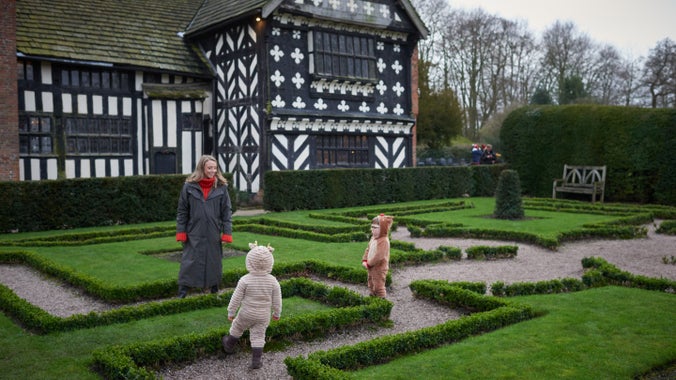
| Asset | Opening time |
|---|---|
| Little Moreton Hall | Closed |
Last entry to the Hall and garden area is 3.30pm. Whole site closes at 4pm.
| Ticket type | With Gift Aid | Without Gift Aid |
|---|---|---|
| Adult (18+) | £16.50 | £15.00 |
| Child (5-17) under 5s free | £8.30 | £7.50 |
| Family (2 Adults and up to 3 children) | £41.30 | £37.50 |
| e.g. 1 adult, 2 children | £24.80 | £22.50 |
Assistance dogs only in the Hall, tea rooms and garden.
Pre-loved bookshop in Welcome Building.
Car park is for visitors to the Hall only.
Spotter activities available throughout the year.
Mrs Dale's Tea-room and Little Tea-room open from 10.30am serving seasonal hot and cold food, drinks, ice creams, savoury and sweet treats.
Level access toilets and baby changing located near Welcome Building. Toilets available just off the Courtyard at the Hall.
Blue Badge parking. Accessible toilet. Steep spiral staircases, uneven floors and cobbled courtyard. Powered Mobility Vehicles and motorised wheelchairs with a maximum width of 0.5 metres can enter Little Moreton Hall. Those that are wider than 0.5 metres can enter the Great Hall where a book of photographs of the upper floors is available, but due to the historic narrow doorways cannot proceed any further. Any Powered Mobility Vehicles wider than 0.5 metres can be left in the courtyard, please speak to a member of our team who can assist with this. Manual wheelchairs are available to borrow.
Ground floor of the Hall only.
Accessible toilet located near the Welcome Building.
Car park is for visitors to the Hall only.
Powered mobility vehicles are not able to enter into Mrs Dale's Tea Room but the Little Tea Room is accessible.
Powered Mobility Vehicles and motorised wheelchairs with a maximum width of 0.5 metres can enter the Great Hall. Those that are wider than 0.5 metres can't go further than the Great Hall due to the historic narrow doorways. A book of photographs of the upper floors is available in the bay window.
Visual Guide of the upper floors is available in the Great Hall.
Cobbles in the courtyard and spiral stairs within the building.
Available to borrow from the Welcome Building and one at the Hall.
///scanner.legwork.untrained - what3words: ///scanner.legwork.untrained
Discover the the iconic Tudor manor house at Little Morton Hall with your group, visit the Tea Rooms, chat to the room guides and living history team, and have a stroll in the garden.

Little Moreton Hall welcomes assistance dogs only throughout the Hall, garden and Tea Rooms. Access to other dogs is very limited. All other dogs on leads are very welcome on the front lawn outside the moat, car park area and the pathway to the canal side walk.

Please use this map to help you plan your visit to Little Moreton Hall.
Iconic wood frame moated Tudor manor house, with wonky angles and quirky character.
Knot garden and borders and traditional viewing mounds. Across the moat is a small orchard with young trees.
Mrs Dale's Tea Room offers hot and cold food and drinks. Little Tea Room offers hot and cold food and drinks and also takeaway options to eat in the garden.
Pre-loved Bookshop selling a range of second-hand books, can be found in the Welcome Building.
Take a step back into the past and celebrate Christmas traditions old and new as Deck the Halls returns to Little Moreton Hall for its final year. See the Tudor house decorated for the season, look out for robins inside and out, and listen to music of the past on weekends in December.
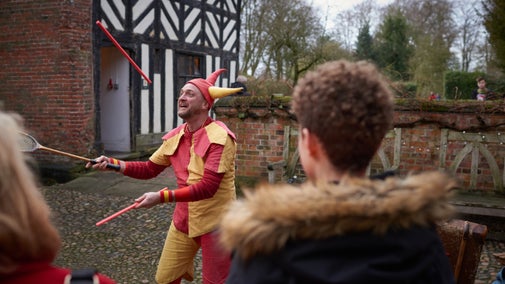
While modern life rushes by outside, Little Moreton Hall, encircled by a moat, survives as a Tudor fantasy, transporting you back to another time. *Hall re-opens on Friday 5 December, for three weekends until Sunday 21 December, for the Christmas Event 'Deck the Hall.' Please explore the website for more details.*

Whether you’re enjoying one of our self-led trails or the wibbly-wobbly floors, there's plenty of free activities to keep the whole family entertained at Little Moreton Hall. *Hall re-opens on Friday 5 December, for three weekends until Sunday 21 December, for the Christmas Event 'Deck the Hall.' Please explore the website for more details.*
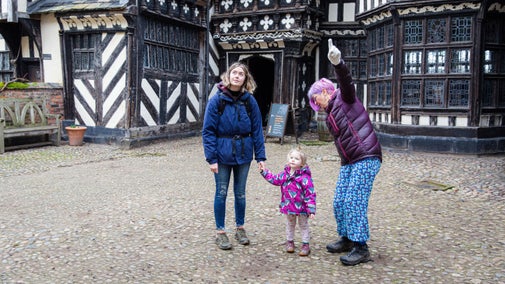
Discover Cheshire’s heritage and nature through grand houses, deer parks, seasonal gardens, woodland, moorland, and even a cotton mill.

The cosy Tea Rooms at Little Moreton Hall offer delicious meals and seasonal treats all year round. The Tea Rooms will be open Friday - Sunday from the 5 December until Sunday 21 December, from 10.30am. The team can't wait to give you a warm and festive welcome.

On your festive wander to look around our 'Deck the Hall' Christmas event, see how many roaming robins you can spot inside and outside of the hall.
Join us this Christmas at Little Moreton Hall for the last year of 'Deck the Hall', and take a step back into the past and celebrate traditions old and new.
Join us at Little Moreton Hall and be a 'Design Detective' for the day. Learn more about how conservators look after historical paintings and designs in the hall, and use the free spotter guide to help you take a closer look.
Where are those wandering wolves? Join us at Little Moreton Hall on this free spotter activity, and help us locate the missing wolves. How many will you discover when you visit?
Join us at Little Moreton Hall this spring and have an Easter adventure in nature. Our Easter trail runs from Saturday 28 March - Sunday 12 April, 10.30am - 4pm. Booking is not required.
What’s the buzz all about? Join us in the outdoor spaces at Little Moreton Hall this May half term and explore our Buzzy Bee spotter trail.
Visit Little Moreton Hall this October half term and 'Escape into autumn.' Discover autumn colours and what wildlife gets up to over the season with our free spotter trail.
A topsy-turvy Tudor house
It’s not your eyes playing tricks on you. Seeing the tumbling architecture of Little Moreton Hall for the first time, engineers in 1990 could not believe their eyes either. This timber-framed building, curled around with a scenic moat, has defied logic for over 500 years. Step back in time inside this higgledy-piggledy house and discover what every day Tudor life tells us about the way we live today.
Find out more
Have a chat with our costumed Living History team on the ground floor, to find out more about how people lived at the Hall. Upstairs, the knowledgeable room guides can answer any questions that you have and remember to ask them about the protective marks carved or burnt into the wooden structure of the building to ward off evil.
Knot just a garden
You’ll find herbs and vegetables that the Tudors would have used for their cooking and medicines surrounding the Elizabethan style knot garden. Take a stroll around the moat to spot creatures great and small who call Little Moreton Hall their home.
Tea-rooms
Enjoy a sandwich and a delicious slice of cake inside the quaint Little Tea Room or soak up the sunshine on the lawn with afternoon tea. You’ll find a different experience in Mrs Dale’s Tea Room with service right to your table, warming dishes and a log-burning stove when it’s nippy.
Discover the ritual protection marks scattered about the house, how the Tudors used to sleep twice a night, and why Little Moreton Hall may be the wonkiest house you’ll ever see.

Take a glimpse into the Moreton family letters held at the British Library, transcribed by our research volunteers, and offering a valuable insight into 17th century life.
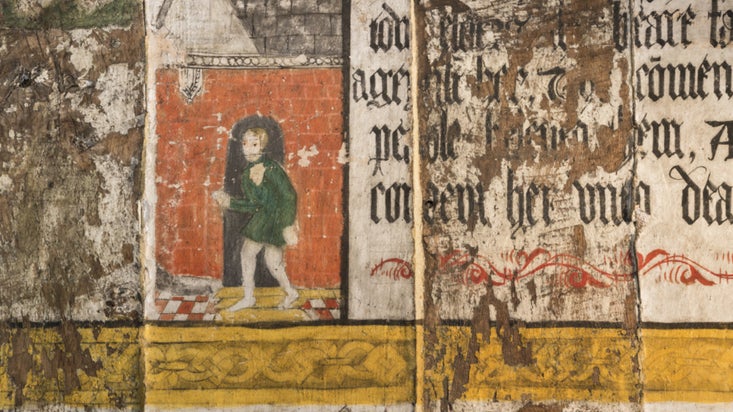
Explore the objects and works of art we care for at Little Moreton Hall on the National Trust Collections website.

Search for live volunteering opportunities, or register your interest with Little Moreton Hall.
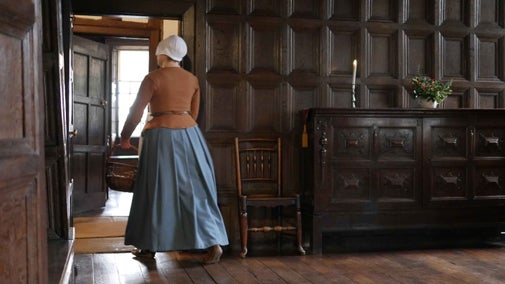
Find out about the supporter groups you can join in Cheshire and Greater Manchester including East Cheshire National Trust Association, South Cheshire Association and The National Trust Chester Centre


Join today and help protect nature, beauty and history – for everyone, for ever. Enjoy access to more than 500 places with National Trust membership.
By sharing your email address you’re agreeing to receive marketing emails from the National Trust and confirm you’re 18 years old or over. Please see our for more information on how we look after your personal data.